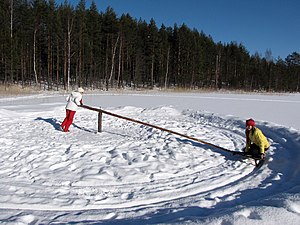Laskiainen

Laskiainen(Finnish pronunciation:[ˈlɑskiɑi̯nen]) is theFinnishcelebration of what is known in the English-speaking world asShrove Tuesday.[1]It is often described as a "mid-winter sledding festival".
Ecclesiastically,Laskiainenis a part ofShrovetideand is a Lutheran celebration just prior to the beginning ofLent,the 40-day season of repentance in Christianity.[2]In Northern Europe, this tradition has been practiced from at least the 7th century onward, and inCatholic countries– in the form ofcarnivals– even before that.
Laskiainenin Finland
[edit]Etymology
[edit]The etymology of the wordlaskiainenis uncertain. Candidates for the source of the word have beenlaskeutua('to descend',as in descent to fasting) orlaskea('to count',as in counting days until Easter).[3][4]According to a third proposal, the word comes from the oldRomancetermcarne lasciare('to leave meat'), with the latter part having changed into a Finnish form.[5]
AsLaskiainenis calledfettisdag('fatty Tuesday') inSwedishafter theFrenchnameMardi Gras,one possible explanation for the Finnish name is simplyläskitiistai('fatty Tuesday'). TheFinnishwordläskicomes from the Swedish wordfläsk,meaning'pork, pork fat'.Fläsktisdagis also part of Swedish culinary traditions.
Traditions
[edit]
The traditions ofLaskiainenconsist largely of merrymaking and feasts.
Many of the FinnishLaskiainentraditions are probably based on an old work feast, where women stopped the winter tasks of workinglinen,hempandwoolandspinningthem intoyarn.[6]Surviving oldLaskiainentraditions include downhill sled riding and riding a sled around a pole.Laskiainenis no longer connected with the growth of flax, but is instead a feast of saying goodbye to the dark winter and waiting for spring.[7]
After theReformation,Finns no longer observed obligatoryfasting,but many beliefs and restrictions stayed in the people's minds.Laskiainenremained a peasant work feast, most importantly as a day belonging towomen's work.An ancient European New Year's Day is situated aroundLaskiainen,which has led to many folk beliefs and spells connected to it in historical Finland. Work had to be stopped early in the afternoon onLaskiainen,in order for work to succeed for the rest of the year. The time forsaunawas during daylight and bathers had to be quiet in the sauna.[8][7]
Food
[edit]
Food items typically enjoyed in Finland inLaskiaineninclude in many casespea soupwith ham, and cheeses.
In the old times,Laskiainenwas a time to eat hearty amounts of meat, because the next opportunity to eat meat only came on Easter after fasting. TraditionalLaskiainenfoods included fattyrieskabread and meat soup. Therieskabread was made frombarleyand spiced with pork fat. The meat soup was cooked frompeasandryegrain and spiced with pig feet or pig head.[9]The soup was also called pig foot soup.
Desserts are also an integral part ofLaskiainen.The best-knownLaskiainendessert, often enjoyed either with coffee or tea, islaskiaispulla,which is a sweet roll filled withalmond pasteor strawberry jam, and whipped cream.[10]This pastry started becoming common in the 19th century.[11]
There were also beliefs about food. Most importantly, food had to be fatty. The more fat glistened on people's fingers and mouths, the more milk the cows gave and the fattier the pigs got, the better. Greasy fingers should not be wiped clean; instead the grease had to be left to clean away on its own. This guaranteed good skills with a scythe. Those who licked their fingers would wound themselves with a scythe. When food was left on the table for the whole day, this guaranteed plenty of food for the rest of the year.[12]
Laskiainenin North America
[edit]
InNorth Americatoo, it is traditional inLaskiainento have a meal of split pea soup with ham, and for amusement – as in Finland – to slide down a hill on either snow-covered or iced tracks, often ontoboggans.
One of the places whereLaskiainenis celebrated outside Europe in form of an annual festival is the community ofPalo,located betweenAuroraandMakinenon the shores of Loon Lake inMinnesota.With this celebration, Palo is the home for one of the longest continuously held annualFinnish-Americanfestivals in the United States,[13]others being e.g. variousSaint Urho's Dayfestivals held each March 16 both in Canada and the United States, and theFinnFest USAfestivals, which have taken place in locations throughout the United States, typically hosted by communities with connections to Finnish-American cultural history.[citation needed]
Many Finnish-North-American groups and clubs host variousLaskiainencelebrations, but the one which developed in Palo in the 1930s is notable for both its size and longevity.[14]
References
[edit]- ^Studia Fennica: Folkloristica.Suomalaisen Kirjallisuuden Seura. 1992. p. 85.ISBN978-951-717-938-6.
- ^"Shrovetide, Ash Wednesday and Lent".Evangelical Lutheran Church of Finland.Retrieved7 April2024.
- ^Oja, Heikki:Aikakirja 2007,p. 147. Almanac office of theUniversity of Helsinki,2007.ISBN952-10-3221-9.Online versionArchived2011-03-22 at theWayback Machine(PDF), accessed on 23 April 2010.
- ^Kolehmainen, Taru:Pääsiäisen "laskiainen"?Archived2012-03-15 at theWayback Machine,Helsingin Sanomat,Kieli-ikkuna, 22 March 2008. Accessed on 7 March 2011.
- ^Renkonen, W. O.:Kulttuurin avainsanoja: Miten ne syntyvät ja kehittyvät,p. 28. Porvoo Helsinki: WSOY, 1954.
- ^Vilkuna, Kustaa:Vuotuinen ajantieto: Vanhoista merkkipäivistä sekä kansanomaisesta talous- ja sääkalenterista enteineen.8th edition (1st edition 1950). Helsinki: Otava, 2002.ISBN951-1-13320-9.
- ^abNieminen, Kirsti:"Laskiainen laulattaa, siansorkka naurattaa"(archived).Ajastaika 1/2002,Ajasto. Accessed on 15 February 2015.
- ^Vuotuisjuhlat: LaskiainenArchived2019-02-07 at theWayback Machine.Helsinki:Finnish literature society.Accessed on 6 February 2019.
- ^Vuorela, Toivo (1975).Suomalainen kansankulttuuri(in Finnish). Porvoo, Helsinki: WSOY.ISBN9789510071908.
- ^MAKOISAT LASKIAISPULLAT - Resepti | Kotikokki.net,www.kotikokki.net.Accessed on 22 January 2021.
- ^Karjalainen, Sirpa:Juhlan aika: Suomalaisia vuotuisperinteitä.Helsinki: WSOY, 1994.ISBN951-0-22920-2.
- ^Savolainen, Irma:Laskiainen ja tuhkakeskiviikko(archived page).City Museum of Helsinki.Accessed on 15 February 2015.
- ^Laskiainen,Finnish American Cultural Activities.
- ^All around the year: holidays and celebrations in American life By Jack Santino (starting on page 87)
